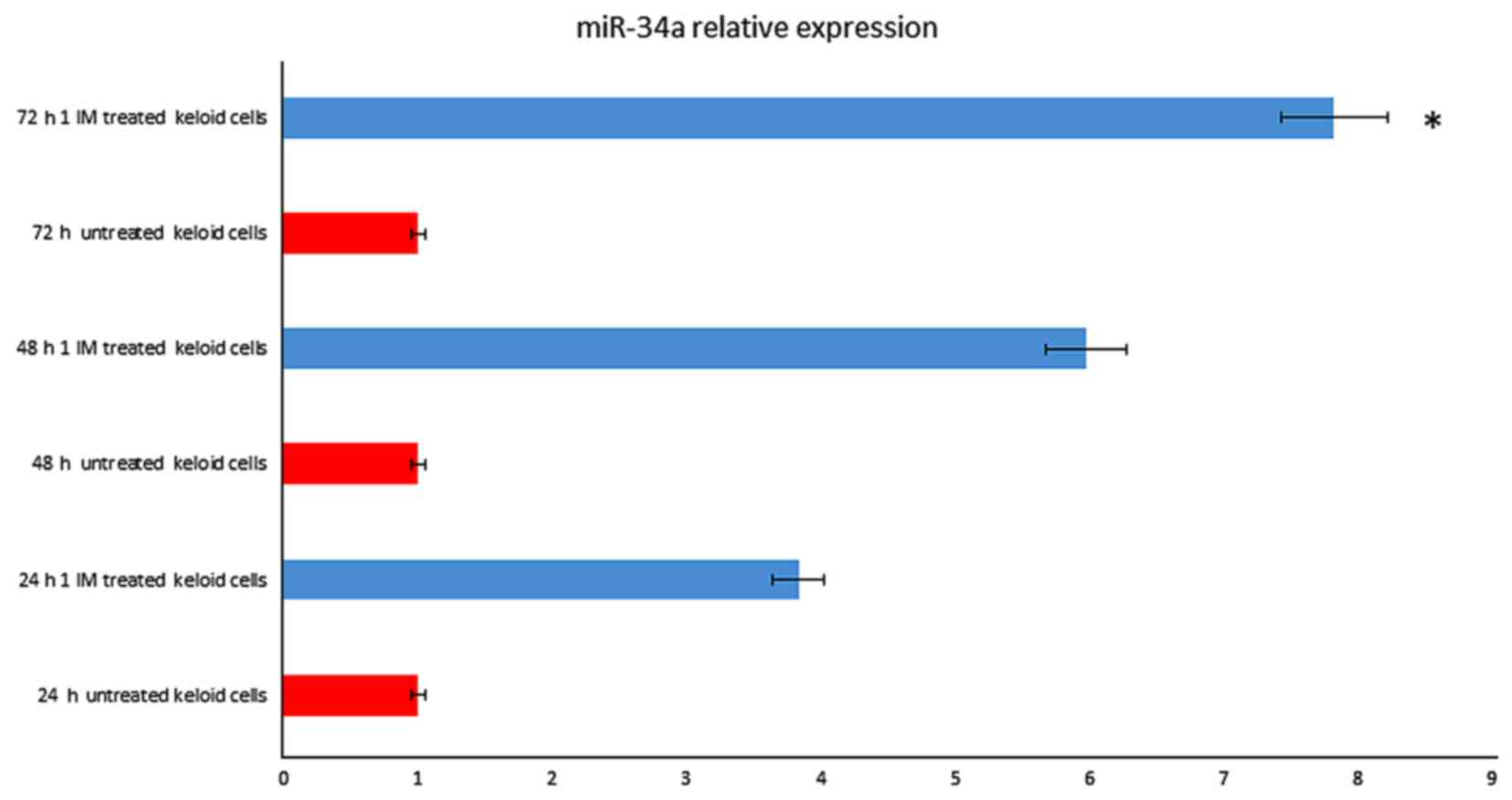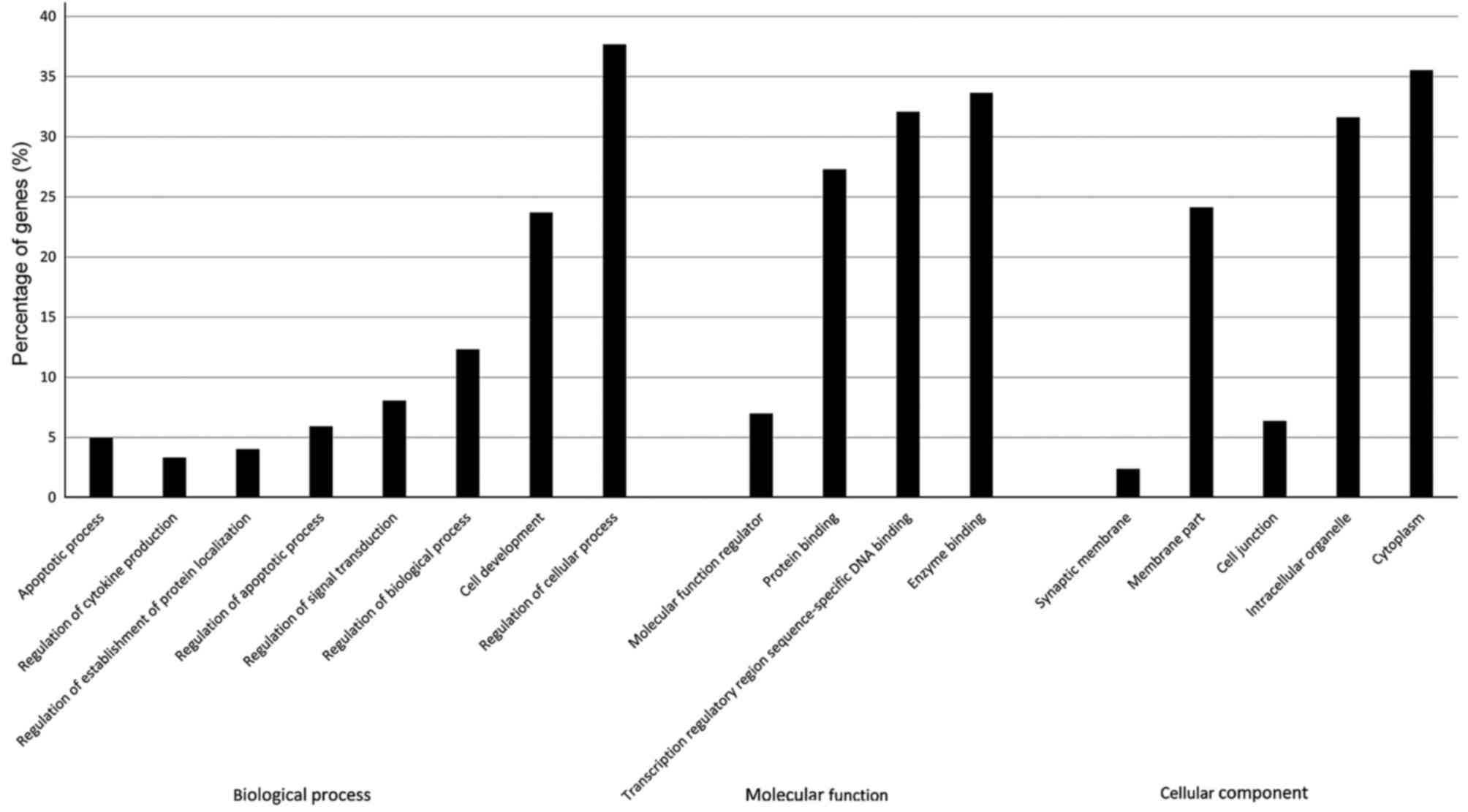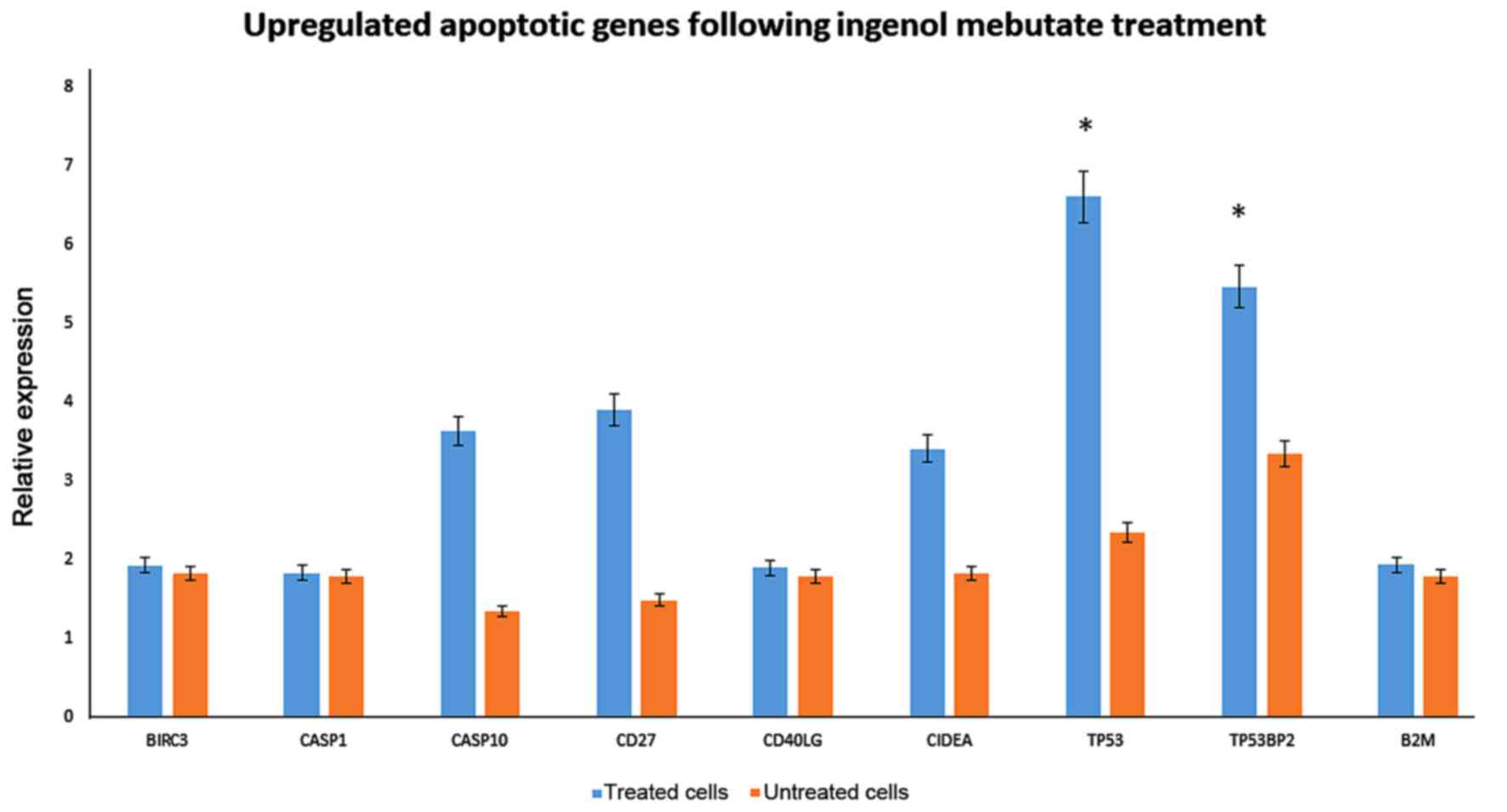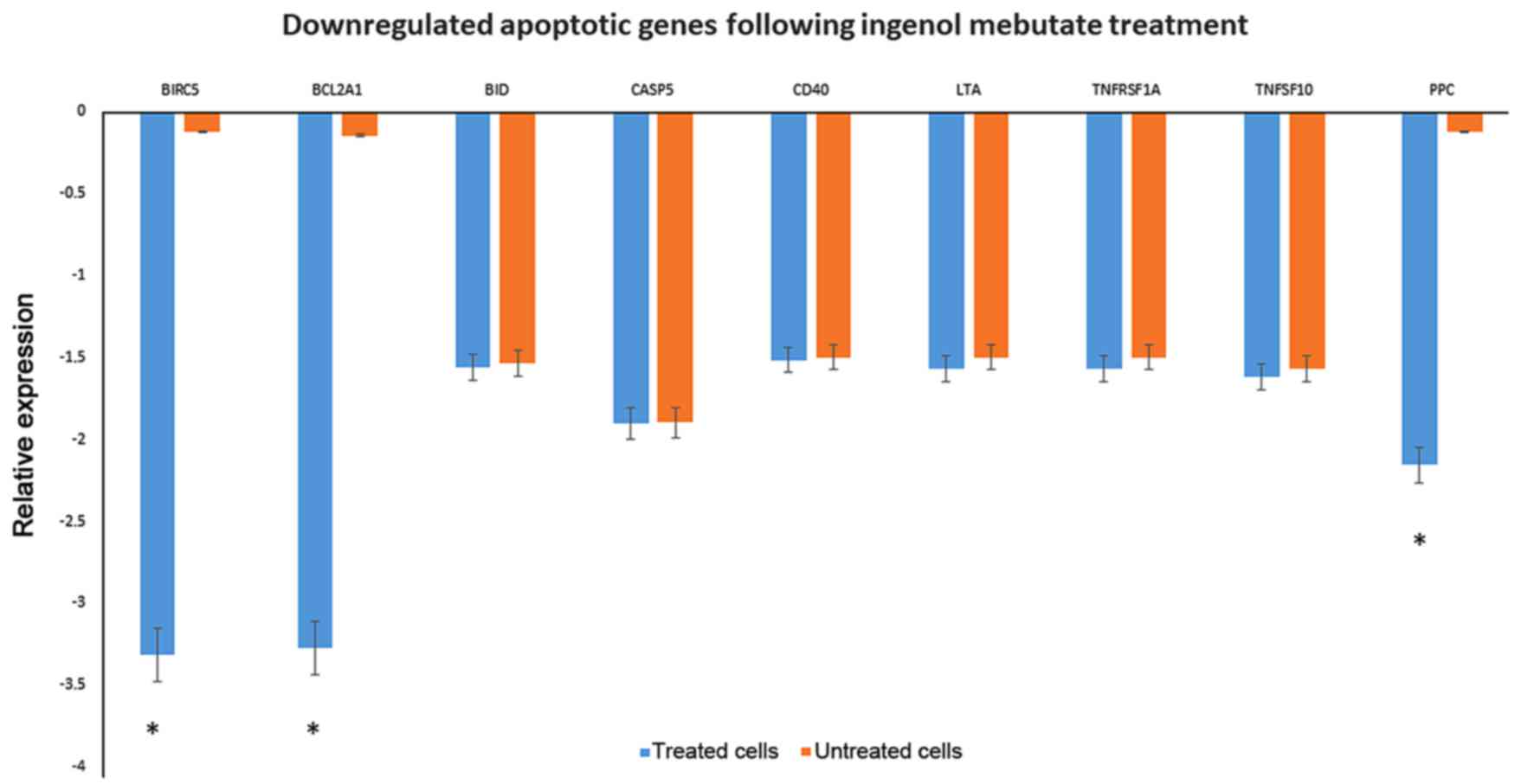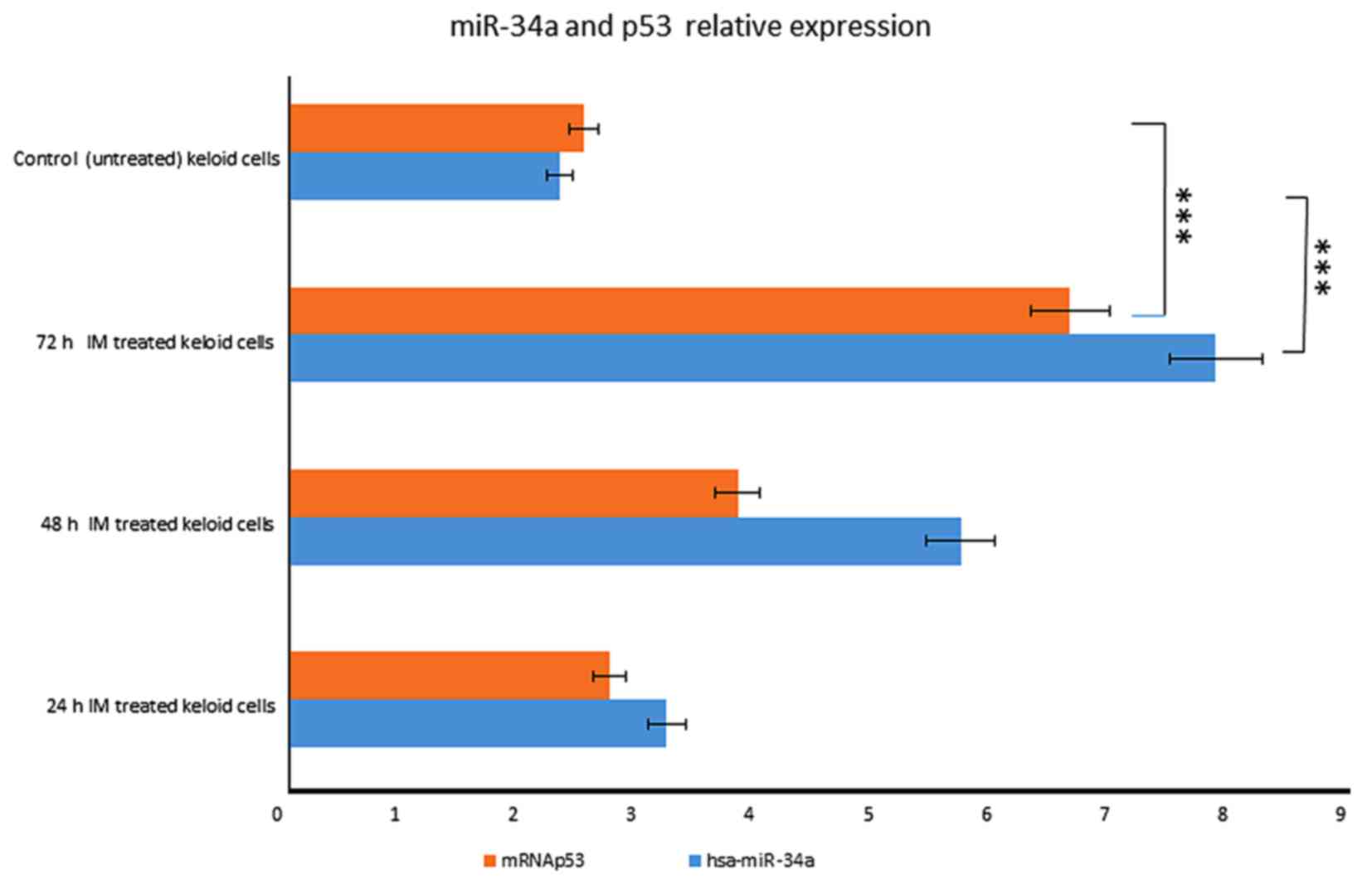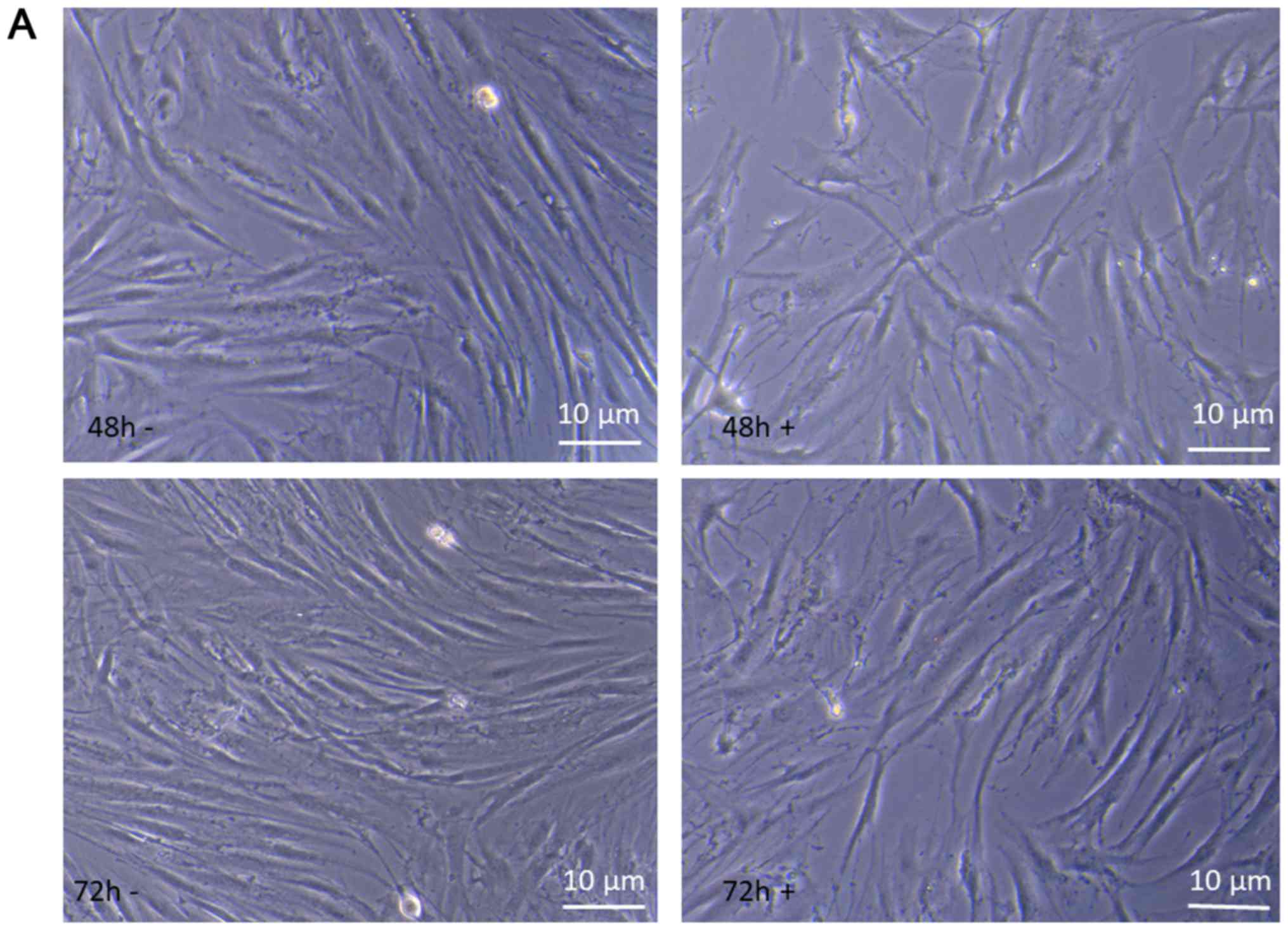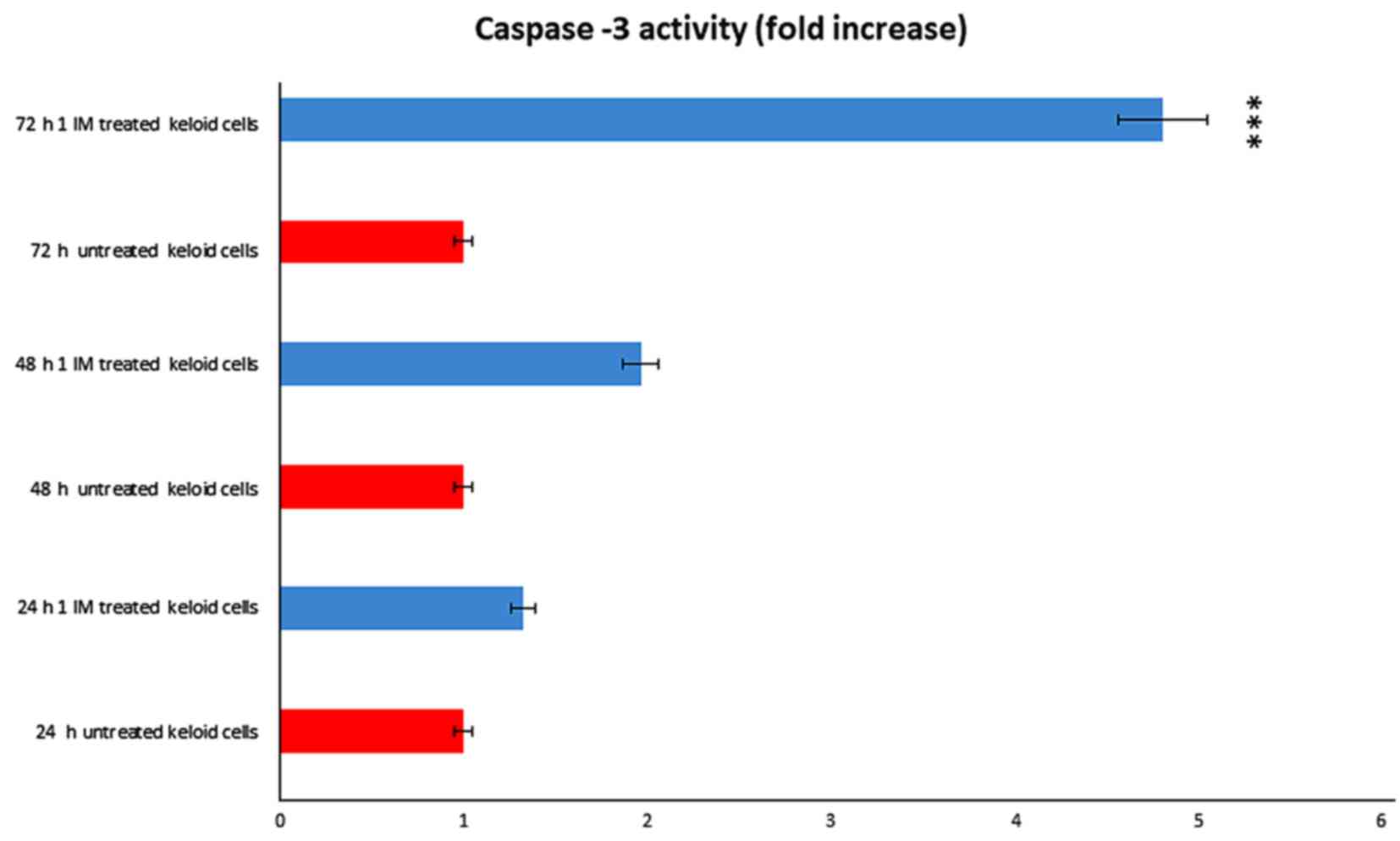miR-34 modulates apoptotic gene expression in Ingenol mebutate treated keloid fibroblasts
- Authors:
- Published online on: March 15, 2018 https://doi.org/10.3892/mmr.2018.8749
- Pages: 7081-7088
-
Copyright: © De Felice et al. This is an open access article distributed under the terms of Creative Commons Attribution License.
Abstract
Introduction
Keloids are fibrotic tumors, which expand over normal skin beyond the margins of the original wound. Keloids do not revert spontaneously and are characterized by the proliferation of dermal fibroblasts, overproduction of extracellular matrix components, especially collagen, elastin, and proteoglycans, fibronectin, an increased infiltration of inflammatory cells (1).
Autosomal dominant with incomplete penetrance as well as autosomal recessive modes of inheritance have been seen among families with keloid disease. Variable gene expression patterns are also implicated in the etiology of keloid disease, but no single gene mutation has thus far been found to be responsible (2). In particular, as reported in multiple microarray studies, keloid-derived fibroblast cells exhibit dysregulated genes involved in apoptosis, mitogen-activated protein kinase, transforming growth factor-beta, interleukin-6 and plasminogen activator inhibitor-1 pathways (3).
Epigenetic alterations in keloid tissue are also involved. Actually, it has been reported that keloid fibroblast cells have altered patterns of DNA methylation, microRNAs deregulation and histone acetylation (4).
No single therapeutic modality is best for all keloids.
Lately, it has been demonstrated that ingenol-mebutate generates pro-apoptotic effects (5), even if the exact mechanism of action is unknown. Multiple apoptotic mechanisms have pleiotropic effects inducing tumor cell death or inhibiting the growth of cancer cells. Due to such outcome, topical application of ingenol mebutate has been successful for the treatment of precancerous skin; therefore, we effectively treated the lesions from a patient showing recurrent keloids with ingenol mebutate (6).
The main apoptotic effects are intermediate through the induction of specific apoptotic target genes.
Multitudes of mechanisms are operated by p53 to guarantee the induction of apoptosis in a stress signal and tissue specific manner. p53 can lead the major steps in apoptotic pathways: The intrinsic mitochondria pathways involving apoptosome realization, the extrinsic death receptor signalling and the direct caspase activation. Numerous of these effects are mediated through the activation of specific p53-target genes.
Recently, it has been shown that components of p53 pathway are direct targets of microRNAs and their over-expression lead to the induction of apoptosis, senescence and cell cycle arrest (7–9).
MicroRNAs (miRNAs) deregulation is recognized as a form of epigenetic regulation. MicroRNAs are small non-coding RNAs approximately 22 nucleotides long able to control gene expression post-transcriptionally through complementarity with a target mRNA, (10). Aberrant microRNA expression has been implicated in several cellular processes and pathogenic pathways of a number of diseases (11–13). Small non-coding RNAs termed microRNAs (miRNAs) can regulate oxidative stress and several human diseases. Recent studies suggest that microRNAs (miRNAs) might play critical roles in pharmacogenomics (14,15). MicroRNA pharmacogenomics is to study the decrease or increase the expressions of microRNAs, target genes or to change the activities of binding microRNAs following to a pharmacological treatment (16).
Since the molecular pathways underlying Ingenol mebutate mechanism of action are still unclear, in the present research, we aim to evaluate the expression levels of microRNAs and differential expression of pro-apoptotic genes expression in keloid fibroblasts following Ingenol-mebutate exposure.
Materials and methods
Cell cultures experiments and treatment
Previously, fresh tissues were obtained from skin lesions of 20 patients with keloids for establishing the primary cell cultures. Primary cell cultures were performed in a previous study (6), then used retrospectively in the present study.
Fibroblasts from keloids were isolated from samples following the same method established by Lim et al (17). All experiments used cells between the second and third passage. No morphological and biochemical differences were found with the passage. Fibroblast cells were grown to confluence in Dulbecco's modified Eagle's medium (DMEM) containing 10% fetal bovine serum (FBS), 10 µg/ml streptomycin, and 50 IU/ml penicillin in 5% carbon dioxide at 37°C.
From the second passage treatment time course experiments were set up for 24, 48, and 72 h without serum starvation, adding different concentrations (0.1, 0.3, 1 µM respectively) of Ingenol Mebutate (Sigma-Aldrich; Merck KGaA, Darmstadt, Germany) dissolved in water.
RNA isolation
Total RNA was isolated from cultured cells using TRIzol reagent (Sigma-Aldrich; Merck KGaA) according to the manufacturer's instructions. Quality of extracted RNA was determined according to 260/280 absorbance ratio, measured by Nano Drop spectrometer (Thermo Fisher Scientific, Inc., Waltham, MA, USA).
TaqMan Reverse transcription-quantitative polymerase chain reaction (RT-qPCR) microRNA array
TaqMan Array Human microRNA Panel Kit (ABI, Forest City, CA, USA) which includes 365 human microRNAs as well as 3 negative controls was used for microRNA expression profile.
For miR-34a analysis, reverse transcription was performed using the TaqMan MicroRNA Reverse Transcription Kit (Thermo Fisher Scientific, Inc.), and PCR products were amplified from cDNA samples using TaqMan MicroRNA Assays (Thermo Fisher Scientific, Inc.). The small nucleolar RNA human RNU48 were used as endogenous controls for normalization of miR-34a expression levels. Fold changes in microRNA expression were calculated using the ΔΔCq method.
Gene ontology analysis (GO)
We analyzed the functional distribution of miR34a target genes using the GO database: http://www.geneontology.org/.
Human apoptosis PCR array
We used the Human Apoptosis RT2 Profiler PCR Array (Qiagen, Inc., Valencia, CA, USA) for the simultaneous human pathway of 84 key genes involved in programmed cell death and the Human Cellular Stress Responses RT2 Profiler PCR Array profiles the expression of 84 genes involved in cellular stress response according to the manufacturer's instructions.
mRNA RT-qPCR analyses
For mRNA analysis, reverse transcription was performed using the High-Capacity Reverse-Transcription Kit (Thermo Fisher Scientific, Inc.). 500 ng/RNA were used in reverse-transcription reaction. RT-qPCR was performed using the SYBR Green method (Bio-Rad Laboratories, Inc., Hercules, CA, USA). Levels of expression were determined by normalization to the housekeeping gene HPRT. PCR primers were purchased from Qiagen (RT2 qPCR Primer Assays).
Phase contrast microscopy
Phase contrast images of control and treated cells were generated with the aid of a Zeiss Axiovert 40 CFL inverted microscope equipped with a Canon Power Shot G6 digital camera.
Annexin V staining
For ANNEXIN V-PI staining, cells were washed with ice-cold PBS, trypsinized, and resuspended in 1× binding buffer [10 mm HEPES/NaOH (pH 7.4), 140 mm NaCl, and 2.5 mm CaCl2] at 1×106 cells/ml. After gentle vortex, the cells were mixed with 5 µl annexin V/fluorescein isothiocyanate (FITC) (Annexin V-FITC Apoptosis Detection kit 3, ABM Inc., USA) and 10 µl propidium iodide (PI) stock solution (50 µg/ml in PBS) followed by a 15 min incubation at room temperature in the dark for apoptosis analysis, following manufacturer's instructions.
DNA fragmentation analysis
The genomic DNA fragmentation was evaluated by agarose gel electrophoresis of DNA. For this purpose, cells were grown in the presence or absence of 3 µM Ingenol Mebutate up to 72 h. After counting and washing, cells were subjected to DNA extraction. The DNA samples were carefully resuspended in TE buffer; the nucleic acid concentration and purity were.
Measured using a NanoDrop® ND-1000 spectrophotometer (Thermo-Scientific, Wilmington, DE, USA). 2 µg of each sample was loaded onto 1.5% TAE agarose gel; DNA laddering was visualized on a UV transilluminator by ethidium bromide staining.
Caspase-3 activity assay
Caspase-3 activity was determined in keloid cells using a colorimetric kit from BioVision Inc., (Milpitas, CA, USA) in accordance with the manufacturer's instructions.
The assay is based on the spectrophotometric detection at 405 nm of the chromophore p-nitroaniline.
(pNA) after cleavage from the labeled substrate DEVDpNA by caspase-3. After Ingenol Mebutate treatment for 48 and 72 h, cells were washed with ice-cold PBS, lysed, centrifuged for 10 min at 10,000 × g. Same volume of cell lysate was added to 50 µl of reaction buffer and 5 µl of specific Caspase-3 substrate (DEVD-pNA).
Statistical analyses
All results shown are mean ± standard deviation of at least three separate experiments, measuring each parameter by triplicate (n=3). Statistical significant differences were tested by one way analysis of variance (ANOVA), and, when the F value was significant, by Student-Newman-Keul's post hoc test. Analysis was performed using UNISTAT version 10 software (Unistat Ltd., Highgate, London, England). P<0.05 was considered to indicate a statistically significant difference.
Results
MicroRNAs differential expression in keloid fibroblasts following Ingenol-mebutate treatment
We examined the microRNA profile in keloid fibroblasts following ingenol-mebutate treatment.
Apoptosis was induced in a dose-dependent manner with Ingenol Mebutate, and we showed the results at 1 microM concentration since they were significant.
Among microRNAs assembled in the list of the TaqMan MicroRNA Assays Human Panel, seven microRNAs (miR-16, −34a, −34b, −34c, -146, -147, and -205) were increased 2-fold or greater in IM-treated (1 Micromol, 72 h) keloid fibroblast cells as compared with untreated cells.
The miR-34 family, miR-34a, −34b, and -34c, were reproducibly induced over 2-fold after IM treatment, whereas four other microRNAs (miR-16, -146, -147, and -205) were not constantly induced. The expression of 17 microRNAs in IM exposed keloid fibroblast cells did not change compared with the untreated cells, representing the microRNA not being responsive to IM.
Among differentially expressed microRNA, relevant microRNAs, as miR-34a, miR-338-5p, mir-24 and let-7, were found strongly up-regulated. MicroRNAs data analysis showed that miR-34a (fold change=7.53; P=0.008) were up-regulated after 72 h treatment (Fig. 1), as well miR-24 (fold change=6.37; P=0.005) and let-7 (fold change=2.88; P=0.003 (data not shown)).
Functional categorization for miR-34a gene targets and Gene-expression analysis
As shown in Fig. 2, the most significantly enriched GO terms identified after screening with a threshold of false discovery rate (FDR) of <0.05. Functional categorization of the GO terms demonstrated that the miR-34a gene targets were strongly associated with biological processes as regulation of biological process, apoptotic process and regulation of apoptotic process. Based on the analysis above, we assumed that the apoptosis pathway is one of the main target for mir-34a (9).
Beside, it has reported that Ingenol Mebutate induce apoptosis in keratosis actinic cells. Therefore, we aimed to understand if similar molecular mechanism is involved in the treatment of keloids with Ingenol Mebutate. Later, in future research, we aim to investigate other molecular pathway too.
Therefore, we explored the consequences of such microRNA up-regulation in Ingenol Mebutate (1 µM after 72 h) treated keloid fibroblasts on 84 genes of the apoptosis pathway using a PCR array. miR-34a overexpression resulted related to a significant up regulation of tp53 and genes that plays a central role in regulation and activation of apoptosis such as tp53bp2, a regulator that plays a central role in regulation of apoptosis and cell growth via its interactions with TP53 (Fig. 3).
Among the up-regulated genes, birc3, casp1, casp10, and CIDEA were detected. Interestingly, CD40 was up-regulated, which is expressed on cultured human fibroblasts, but also shifted fibroblasts into the G0/G1 phase of the cell cycle.
The down-regulation of Bid, casp5, cd40, cd70, and members of Tumor necrosis factor receptor superfamily as TNFRSF1A and TNFSF10, leading to signalling complexes that activate both the apoptotic caspase cascade and the NF-κB and JNK anti-apoptotic pathways, were observed among the list. Genes associated with the inhibition of apoptosis as birc5 and bcl2a1 were highly down-regulated (Fig. 4).
miR-34a induction depends on p53 activation
In particular, miR-34a expression was increased in a time-dependent manner after IM treatment, rising 3.2-fold at 24 h until 7 fold at 72 h (Fig. 1). We also observed that p53 started to increase at 24 h, respectively, and the increasing continued until 72 h after treatment (Fig. 5).
These results indicate that miR-34a is induced in a p53-dependent manner after IM treatment.
Ingenol mebutate induces apoptosis-like phenotypes
We observed that introduction of Ingenol Mebutate in keloid fibroblast cells caused apoptosis-like phenotypes showing similar morphological changes with enlarged cellular size.
The behavior of keloid fibroblasts over the 72 h period of treatment with 1 µM Ingenol Mebutate was monitored by phase-contrast microscopy and high enlargement pictures analyzed. As shown in Fig. 6A at 48 and 72 h of incubation time, comparing treated to untreated keloid fibroblasts morphological changes are evident that strongly suggest alterations in the cytoskeleton organization, impairment of cell growing, differentiation and development. These results suggest that suppression of cell proliferation by Ingenol Mebutate could be mainly associated with the induction of apoptosis-like phenotypes. Therefore, we evaluated apoptosis with Annexin V assay. As shown in Fig. 6B, staining revealed Annexin V-positive/PI negative, apoptotic, keloid cells after 72 h ingenol mebutate treatment. Quantification of the annexin was not assayed.
Ingenol mebutate induces DNA fragmentation
To verify if Ingenol Mebutate could induce DNA fragmentation and thus to confirm whether apoptosis occurred, keloid fibroblasts exposed to treatment were assessed for DNA laddering by agarose gel electrophoresis (Fig. 7). We found that treated keloid fibroblasts after 48 and 72 h of incubation with 1 Micromol Ingenol mebutate, showed apoptotic DNA fragmentation profiles. On the opposite, no nucleic acid fragmentation was observed in negative controls represented by untreated cells.
Apoptotic effect mediated through caspase-3
We evaluated the potential contribution of caspase-3 in Ingenol mebutate treated keloid cells. We obtained that caspase-3 was significantly activated after treatment (Fig. 8). We observed a dose and a time dependent effect, obtaining a significant result after 72 h of incubation with 1 Micromol Ingenol mebutate.
Discussion
Keloids are benign tumors that resist all clinical therapies and often recur, compromising the quality of life of many patients. Since pro-apoptotic effects of this drug have been demonstrated in several malignant cells (5), in a previous research we successfully treated a woman with a large keloid with Ingenol mebutate (6). So far, there is no molecular study on its effect on keloid fibroblasts.
Here, to explore such novel treatment modalities for keloids and to elucidate the molecular mechanism of IM treatment in keloid fibroblasts, we analyzed the microRNA and gene apoptosis expression patterns in keloid fibroblasts following exposure to Ingenol mebutate, by array strategy.
Current studies have suggested that microRNAs regulates gene expression and play important roles in mediating responses of drug molecules (18). microRNAs can regulate the expression of drug transporters and drug targets. Following Ingenol-mebutate exposure, we identified miR-34a as a major microRNA that is induced in in keloid fibroblasts.
miR-34 is a direct targets of p53 and their over-expression results in the induction of apoptosis, cell cycle arrest and senescence (7,9,19). Beside, miR-34a could partially replace p53 in inducing apoptosis or senescence. p53 directly can activate the expression of miR-34 genes, which play an important role in p53-mediated apoptotic pathway (20). Activation of miR-34a by p53 may contribute to induction of apoptosis. The miR-34a gene itself may be a tumor suppressor gene since it maps to a region on chromosome 1p36 which is commonly deleted in neuroblastoma.
The p53 tumor-suppressor protein activates a mass of genes encoding proteins with roles in apoptosis, DNA repair, senescence, and cell-cycle control. miR-34 might be key effectors of p53 tumor-suppressor function, and the inactivation might contribute to definite cancers.
Due to IM exposure in keloid fibroblasts, genotoxic stress activated p53 transcription of many genes, leading to cell cycle arrest, apoptosis or senescence (21). microRNAs, as the miR-34 family, are transcriptionally activated by p53. In turn microRNAs regulate expression of many p53-induced genes.
However, the outcome of miR-34a overexpression on p53 levels and role depends on cellular setting (7). In order to evaluate the association between the regulation of miR-34 with pro-apoptotic gene expression in Ingenol Mebutate treated keloid fibroblast, we measured expression levels of the apoptosis pathway gene was here investigated using a PCR array. We found a positive correlation between the increase of miR-34 and p53 expression.
Tp53 plays a central role in regulation and activation of apoptosis in Ingenol Mebutate treated keloid fibroblasts, since was up-regulated as well as tp53bp2, a regulator that plays a central role in regulation of apoptosis and cell growth via its interactions with TP53. Among the up-regulated genes, more apoptotic genes as birc3, casp1, casp10, and CIDEA were identified. Such genes plays a central role in the execution-phase of cell apoptosis and regulate also inflammatory signaling and immunity.
miR-34 family were shown to suppress tumor growth and metastasis by promoting processes that inhibit carcinogenesis, such as apoptosis and senescence. MiR-34 regulate these processes through downregulation of their target mRNAs. As of today, more than 77 miR-34 targets have been confirmed (22). Among miR-34 target gene, we detected birc5 and bcl2a1, genes associated with the inhibition of apoptosis, that were down-regulated.
The expressions of more miR34a target genes, such as Notch1, Delta1, Bcl2 or E2F3 in Ingenol Mebutate treated cells, will be examined in next researches.
The molecular results have been confirmed by the behavior of keloid fibroblasts over the 72 h period of treatment with 1 µM Ingenol Mebutate that was monitored by phase-contrast microscopy. Microscope observations showed an apoptosis-like phenotype such as accumulation of typical membrane blebbing, containing cytoplasm and encircled by multilayered lamellar structures, as well as fingerprint profiles and apparent mitochondrial swelling. DNA fragmentation Ingenol treated fibroblasts is also a hallmark of cell apoptosis. Apoptotic effect of Ingenol Mebutate effect on keloid cells was confirmed by Annexin-V staining and caspase-3 assay.
All together, these results indicate that Ingenol mebutate induce fibroblasts growth inhibition by the promotion of apoptosis.
Our results show, for the first time, that Ingenol Mebutate treatment induce DNA damage, which is able to generate the apoptotic response in keloid fibroblasts with higher expression of miR-34, probably because of a strong interaction between p53 and miR-34, which is a direct transactivational target of p53, inducing apoptosis, cell cycle arrest and senescence. Following Ingenol Mebutate treatment, miR-34 may modulates the pro-apoptotic genes expression promoting apoptosis in a p53-independent manner and in a p53-dependent manner.
These events all promote cell apoptosis. Our findings show that the miR-34a regulates cell-cycle progression and apoptosis together with p53 following Ingenol mebutate exposure. We put down a groundwork for further experiments in order to progress these challenges in the future.
Acknowledgements
The authors thank Professor Paolo Mondola (University of Naples ‘Federico II’, Naples, Italy), who greatly encouraged us to continue this study.
Funding
The present study was supported partly by a research grant from the University of Naples II, Italy (grant no. Grant L.R. N.5 2007).
Availability of data and materials
The datasets used and/or analyzed during the current study are available from the corresponding author on reasonable request.
Authors' contributions
BDF performed all of the experiments and wrote the manuscript. CG and MS performed microscope observations. FM interpreted the data, corrected the English and helped draft the manuscript. MN designed the present study, critically revised the manuscript for intellectual content and gave final approval of the version to be published.
Ethics approval and consent to participate
Not applicable.
Consent for publication
Not applicable.
Competing interests
The authors declare that they have no competing interests.
Glossary
Abbreviations
Abbreviations:
|
miR/miRNA |
microRNA |
|
p53 |
tumor protein p53 |
References
|
Halim AS, Emami A, Salahshourifar I and Kannan TP: Keloid scarring: Understanding the genetic basis, advances and prospects. Arch Plast Surg. 3:184–189. 2012. View Article : Google Scholar | |
|
Shih B and Bayat A: Genetics of keloid scarring. Arch Dermatol Res. 5:319–339. 2010. View Article : Google Scholar | |
|
Chen W, Fu X, Sun X, Sun T, Zhao Z and Sheng Z: Analysis of differentially expressed genes in keloids and normal skin with cDNA microarray. J Surg Res. 113:208–216. 2003. View Article : Google Scholar : PubMed/NCBI | |
|
Russell SB, Russell JD, Trupin KM, Gayden AE, Opalenik SR, Nanney LB, Broquist AH, Raju L and Williams SM: Epigenetically altered wound healing in keloid fibroblasts. J Invest Dermatol. 130:2489–2496. 2010. View Article : Google Scholar : PubMed/NCBI | |
|
Stahlhut M, Bertelsen M, Hoyer-Hansen M, Svendsen N, Eriksson AH, Lord JM, Scheel-Toellner D, Young SP and Zibert JR: Ingenol mebutate: Induced cell death patterns in normal and cancer epithelial cells. J Drugs Dermatol. 11:1181–1192. 2012.PubMed/NCBI | |
|
De Felice B, Guida M, Boccia L and Nacca M: Ingenol mebutate treatment in keloids. BMC Res Notes. 8:4662015. View Article : Google Scholar : PubMed/NCBI | |
|
Navarro F and Lieberman J: miR-34 and p53: New insights into a complex functional relationship. PLoS One. 10:e01327672015. View Article : Google Scholar : PubMed/NCBI | |
|
Tarasov V, Jung P, Verdoodt B, Lodygin D, Epanchintsev A, Menssen A, Meister G and Hermeking H: Differential regulation of microRNAs by p53 revealed by massively parallel sequencing: miR-34a is a p53 target that induces apoptosis and G1-arrest. Cell Cycle. 3:1586–1593. 2007. View Article : Google Scholar | |
|
Hermeking H: The miR-34 family in cancer and apoptosis. Cell Death Differ. 17:193–199. 2010. View Article : Google Scholar : PubMed/NCBI | |
|
Liu X, Fortin K and Mourelatos Z: MicroRNAs: Biogenesis and molecular functions. Brain Pathol. 18:113–121. 2008. View Article : Google Scholar : PubMed/NCBI | |
|
Beermann J, Piccoli MT, Viereck J and Thum T: Non-coding RNAs in development and disease: Background, mechanisms and therapeutic approaches. Physiol Rev. 96:1297–1325. 2016. View Article : Google Scholar : PubMed/NCBI | |
|
Ebert MS and Sharp PA: Roles for microRNAs in conferring robustness to biological processes. Cell. 149:515–524. 2012. View Article : Google Scholar : PubMed/NCBI | |
|
De Felice B, Guida M, Guida M, Coppola C, De Mieri G and Cotrufo R: A miRNA signature in leukocytes from sporadic amyotrophic lateral sclerosis. Gene. 508:35–40. 2012. View Article : Google Scholar : PubMed/NCBI | |
|
Rukov JL and Shomron N: MicroRNA pharmacogenomics: Post-transcriptional regulation of drug response. Trends Mol Med. 17:412–423. 2011. View Article : Google Scholar : PubMed/NCBI | |
|
Koturbash I, Tolleson WH, Guo L, Yu D, Chen S, Hong H, Mattes W and Ning B: MicroRNAs as pharmacogenomics biomarkers for drug efficacy and drug safety assessment. Biomark Med. 9:1153–1176. 2015. View Article : Google Scholar : PubMed/NCBI | |
|
Shomron N: MicroRNAs and pharmacogenomics. Pharmaco-genomics. 11:629–632. 2010. | |
|
Lim IJ, Phan TT, Song C, Tan WT and Longaker MT: Investigation of the influence of keloid-derived keratinocytes on fibroblast growth and proliferation in vitro. Plastic Reconstr Surg. 107:797–808. 2001. View Article : Google Scholar | |
|
He Y, Chevillet JR, Liu G, Kim TK and Wang K: The effects of microRNA on the absorption, distribution, metabolism and excretion of drugs. Br J Pharmacol. 172:2733–2747. 2015. View Article : Google Scholar : PubMed/NCBI | |
|
Chang TC, Wentzel EA, Kent OA, Ramachandran K, Mullendore M, Lee KH, Feldmann G, Yamakuchi M, Ferlito M, Lowenstein CJ, et al: Transactivation of miR-34a by p53 broadly influences gene expression and promotes apoptosis. Mol Cell. 26:745–752. 2007. View Article : Google Scholar : PubMed/NCBI | |
|
Raver-Shapira N, Marciano E, Meiri E, Spector Y, Rosenfeld N, Moskovits N, Bentwich Z and Oren M: Transcriptional activation of miR-34a contributes to p53-mediated apoptosis. Mol Cell. 26:731–743. 2007. View Article : Google Scholar : PubMed/NCBI | |
|
Oren M: Decision making by p53: Life, death and cancer. Cell Death Differ. 10:431–442. 2003. View Article : Google Scholar : PubMed/NCBI | |
|
Rokavec M, Li H, Jiang L and Hermeking H: The p53/miR-34 axis in development and disease. J Mol Cell Biol. 6:214–230. 2014. View Article : Google Scholar : PubMed/NCBI |



